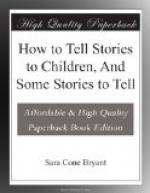How I remember the delightful sense of achievement which stole into the little girl’s veins when the voice behind her said “just right.” I think she always chuckled a little, and hugged her stomach. So the story progressed, and the little girl got through her toilet without crying, owing to the wonder-working voice and its marvellous adaptation of climaxes to emergencies. Nine times out of ten, it was the story of The Three Bears she demanded when, with the appearance of brush and comb, the voice asked, “Which story shall mother tell?”
It was a memory of the little girl in the pink room which made it easy for me to understand some other children’s preferences when I recently had occasion to inquire about them. By asking many individual children which story of all they had heard they liked best, by taking votes on the best story of a series, after telling it, and by getting some obliging teachers to put similar questions to their pupils, I found three prime favourites common to a great many children of about the kindergarten age. They were The Three Bears, Three Little Pigs, and The Little Pig that wouldn’t go over the Stile.
Some of the teachers were genuinely disturbed because the few stories they had introduced merely for amusement had taken so pre-eminent a place in the children’s affection over those which had been given seriously. It was of no use, however, to suggest substitutes. The children knew definitely what they liked, and though they accepted the recapitulation of scientific and moral stories with polite approbation, they returned to the original answer at a repetition of the question.
Inasmuch as the slightest of the things we hope to do for children by means of stories is quite impossible unless the children enjoy the stories, it may be worth our while to consider seriously these three which they surely do enjoy, to see what common qualities are in them, explanatory of their popularity, by which we may test the probable success of other stories we wish to tell.




